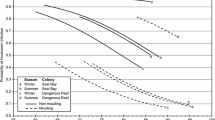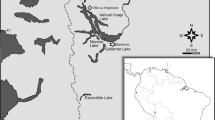Abstract
At least two species of filarial worms, Dirofilaria immitis and Acanthocheilonema (Dipetalonema) odendhali, infect otariid pinnipeds, including the California sea lion (Zalophus californianus). To date, evidence of infection in sea lions has come from dead or captive animals, and little is known about filariasis in free-living populations. We sampled 45 California sea lion adults and 197 pups captured at 12 rookeries from different ecological regions within the Gulf of California and detected and quantified D. immitis and A. odendhali microfilariae in blood smears. We investigated differences in prevalence and parasite load (intensity of infection) among ecological regions. Microfilariae were detected in the blood of 35 of the 45 (77.78%) adult females and in 1 of the 197 (0.51%) pups examined. The average burden of A. odendhali per microlitre of blood was nearly twice that of D. immitis. Prevalence and intensity of infection differed significantly among regions, being highest for colonies within the northern and northcentral regions and lowest in the southern region. Dirofilaria immitis and A. odendhali infections displayed a similar spatial pattern of prevalence. Colony density inversely predicted the prevalence of microfilariae. Based on the clinical parameters typically associated with filarial infections in carnivores and physical examinations, none of the sea lions appeared to have evidence of disease. This is a first approximation to investigate the prevalence of microfilaria infections in free-ranging California sea lions and to explore their relevance to population health.




Similar content being viewed by others
References
Abrams PA (1982) Functional responses of optimal foragers. Am Nat 120:382–390
Adame-Fernández K (2018) Abundancia y hábitat terrestre del lobo marino de California en el Golfo de California. Dissertation. Instituto Politécnico Nacional, La Paz
Alexander N (2012) Analysis of parasite and other skewed counts. Tropical Med Int Health 17:684–693
Alho AM, Marcelino I, Colella V, Flanagan C, Silva N, Correia JJ, Latrofa MS, Otranto D, Madeira de Carvalho L (2017) Dirofilaria immitis in pinnipeds and a new host record. Parasit Vectors 10:142
Arbune M, Dobre M (2015) Dirofilariasis - an emergent human parasitosis in Romania. Acta Parasitol 60:485–487
Atkins CE, De Francesco TC, Coats JR, Sidley JA, Keene BW (2000) Heartworm infection in cats: 50 cases. J Am Med Assoc 217:355–358
Aurioles-Gamboa D, Zavala-González A (1994) Algunos factores ecológicos que determinan la distribución y abundancia del lobo marino Zalophus californianus, en el Golfo de California. Cienc Mar 20:535.553
Ayres JS, Schneider DS (2012) Tolerance of infections. Annu Rev Immunol 30:271–294
Banuet-Martínez M, Espinosa-de Aquino W, Elorriaga-Verplancken FR, Flores-Morán A, García OP, Camacho M, Acevedo-Whitehouse K (2017) Climatic anomaly affects the immune competence of California sea lions. PLoS One 12(6):e0179359
Barbosa P, Hines J, Kaplan I, Martinson H, Szczepaniec A, Szendrei Z (2009) Associational resistance and associational susceptibility: having right or wrong neighbours. Ann Rev Ecol Evol Sys 40:1–20
Barriga OO (2002) Las enfermedades parasitarias de los animales domésticos en la América Latina. Editorial Germinal, Santiago
Baucom RS, de Roode JC (2011) Ecological immunology and tolerance in plants and animals. Funct Ecol 25:18–28
Beldomenico PM, Begon M (2010) Disease spread, susceptibility and infection intensity: vicious circles? Trends Ecol Evol 25:21–27
Brock PM, Hall AJ, Goodman SJ, Cruz M, Acevedo-Whitehouse K (2013) Immune activity, body condition and human-associated environmental impacts in a wild marine mammal. PLoS One 8(6):e67132
Calvert CA, Rawlings CA (1988) Canine heartworm disease. In: Fox PR (ed) Canine and feline cardiology. Churchill Livingstone, New York, pp 551–549
Capelli G, Genchi C, Baneth G, Bourdeau P, Brianti E, Cardoso L, Danesi P, Fuehrer HP, Giannelli A, Ionică AM, Maia C, Modrý D, Montarsi F, Krücken J, Papadopoulos E, Petrić D, Pfeffer M, Savić S, Otranto D, Poppert S, Silaghi C (2018) Recent advances on Dirofilaria repens in dogs and humans in Europe. Parasit Vectors 11:663. https://doi.org/10.1186/s13071-018-3205-x
Case TJ, Cody ML (1983) Island biogeography in the Sea of Cortes. University of California Press, Berkeley
Chipeta MG, Ngwira BM, Simoonga C, Kazembe LN (2014) Zero adjusted models with applications to analysing helminths count data. BMC Res Notes 7:856
Crawley MJ (2002) Statistical computing, an introduction to data analysis using S-plus. John Wiley and Sons, Chichester
Dailey MD (1980) Diagnostic key to the parasites of some marine mammals. Naval Ocean Systems Center, San Diego
Dailey MD (2001) Parasitic diseases. In: Dierauf L, Gulland FMD (eds) CRC handbook on marine mammal medicine: health, disease, and rehabilitation. CRC Press, Boca Raton, pp 357–397
Development Core Team R (2018) R: a language and environment for statistical computing. R Foundation for Statistical Computing, Vienna http://www.R-project.org
Eskelson BN, Madsen L, Hagar JC, Temesgen H (2011) Estimating riparian understory vegetation cover with Beta regression and copula models. For Sci 57:212–221
Flores-Morán A, Banuet-Martínez M, Elorriaga-Verplancken FR, García-Ortuño LE, Sandoval-Sierra J, Acevedo-Whitehouse K (2017) Atypical red blood cells are prevalent in California sea lion pups born during anomalous sea surface temperature events. Physiol Biochem Zool 90:564–574
Forrester DJ, Jackson RF, Miller JF, Townsend BC (1973) Heartworms in captive California sea lions. J Am Vet Med Assoc 163:568–570
Ganser C, Wisely SM (2013) Patterns of spatio-temporal distribution, abundance, and diversity in a mosquito community from the eastern Smoky Hills of Kansas. J Vector Ecol 38:229–236
Genchi C, Mortarino M, Rinaldi L, Cringoli G, Traldi G, Genchi M (2011) Changing climate and changing vector-borne disease distribution: the example of Dirofilaria in Europe. Vet Parasitol 176:295–299
Hoerauf A, Pfarr K, Mand S, Debrah AY, Specht S (2011) Filariasis in Africa--treatment challenges and prospects. Clin Microbiol Infect 17:977–985
Horobin RW (2011) How Romanowsky stains work and why they remain valuable - including a proposed universal Romanowsky staining mechanism and a rational troubleshooting scheme. Biotech Histochem 86:36–51
Ionică AM, Matei IA, D'Amico G, Ababii J, Daskalaki AA, Sándor AD, Enache DV, Gherman CM, Mihalca AD (2017) Filarioid infections in wild carnivores: a multispecies survey in Romania. Parasit Vectors 10:332
Izquierdo-Suzán M (2014) Caracterización estructural y genética de parásitos de lobo marino de California, Zalophus californianus en Ángel de la Guarda y Granito, Golfo de California. Dissertation. Universidad Autónoma de Querétaro, Mexico
Krasnov BR, Khokhlova IS, Shenbrot GI (2003) Density-dependent host selection in ectoparasites: an application of isodar theory to fleas parasitizing rodents. Oecol 134:365–372
Krucik DD, Van Bonn W, Johnson SP (2016) Association between positive canine heartworm (Dirofilaria immitis) antigen results and presence of Acanthocheilonema odendhali microfilaria in California sea lions (Zalophus californianus). J Zoo Wildl Med 47:25–28
Lauckner G (1985) Diseases of mammalia: Pinnipedia. In: Kinne O (ed) Diseases of marine animals. Biologische Angstalt Helgoland, Hamburg, pp 683–793
Martínez-Palacios A (1983) Notas sobre los mosquitos de Baja California, México (Diptera: Culicidae). Folia Entomol Mex 69:99–116
McCallum H, Barlow N, Hone J (2001) Should pathogen transmission be modelled? Trends Ecol Evol 16:295–300
Mcgrotty Y, Knottenbelt C (2002) Significance of plasma protein abnormalities in dogs and cats. In Pract 24:512–517
Mehlorn H (2015) Filarial worms of animals. Encyclopedia of Parasitology. Springer, Berlin, Heidelberg
Murray MD (1987) Arthropods. The pelage of mammals as an environment. Int J Parasitol 17:191–195
Murray MD, Nicholls DG (1965) Studies on the ectoparasites of seals and penguins I. The ecology of the louse Lepidophthirus macrorhini Enderlein on the southern elephant seal, Mirounga leonina (L.). Aust J Zool 13:437–454
Niwetpathomwat A, Kaewthamasorn M, Tiawsirisup S, Techangamsuwan S, Suvarnvibhaja S (2007) A retrospective study of the clinical hematology and the serum biochemistry tests made on canine dirofilariasis cases in an animal hospital population in Bangkok, Thailand. Res Vet Sci 82:364–369
Okuyama T (2016) Parasitoid aggregation and interference in host–parasitoid dynamics. Ecol Entomol 41:473–479
Patz JA, Grabow ML, Limaye VS (2014) When it rains, it pours: future climate extremes and health. Ann Glob Health 80:332–344
Peñín I, Figueroa-Cabañas ME, Guerrero-de la Rosa F, Soto-García LA, Álvarez-Martínez R, Flores-Morán AE, Acevedo-Whitehouse K (2019) Transcriptional profiles of California sea lion peripheral NK and CD +8 T cells reflect ecological regionalization and infection by oncogenic viruses. Front Immunol 12(10):413
Råberg L, Graham AL, Read AF (2009) Decomposing health: tolerance and resistance to parasites in animals. Philos Trans R Soc B 364:37–49
Roletto J (1993) Hematology and serum chemistry values for clinically healthy and sick Pinnipeds. J Zoo Wildl Med 24:145–157
Rueden CT, Schindelin J, Hiner MC, DeZonia BE, Walter AE, Arena ET, Eliceiri KW (2017) ImageJ2: ImageJ for the next generation of scientific image data. BMC Bioinformatics 18:529
Ryan SJ, Carlson CJ, Mordecai EA, Johnson LR (2019) Global expansion and redistribution of Aedes-borne virus transmission risk with climate change. PLoS Negl Trop Dis 13(3):e0007213. https://doi.org/10.1371/journal.pntd.0007213
Sassnau R, Daugschies A, Lendner M, Genchi C, Sato T, Higuchi T, Shibuya H (2014) Climate suitability for the transmission of Dirofilaria immitis and D. repens in Germany. Vet Parasitol 205:239–245
Seguel M, Montalva F, Pérez-Venegas D, Gutiérrez J, Paves HJ, Müller A, Valencia-Soto C, Howerth E, Mendiola V, Gottdenker N (2018) Immune-mediated hookworm clearance and survival of a marine mammal decrease with warmer ocean temperatures. Elife 7:e38432
Simón F, Kramer LH, Román A, Blasini W, Morchón R, Marcos-Atxutegi C, Grandi G, Genchi C (2007) Immunopathology of Dirofilaria immitis infection. Vet Res Commun 31:161–171
Simón F, Siles-Lucas M, Morchón R, González-Miguel J, Mellado I, Carretón E, Montoya-Alonso JA (2012) Human and animal dirofilariasis: the emergence of a zoonotic mosaic. Clin Microbiol Rev 25:507–544
Simpson JE, Hurtado PJ, Medlock J, Molaei G, Andreadis TG, Galvani AP, Diuk-Wasser MA (2012) Vector host-feeding preferences drive transmission of multi-host pathogens: West Nile virus as a model system. Proc Biol Sci 279:925–933
Soulsby EJL (1982) Helminths, arthropods and protozoa of domesticated animals. Baillière Tindall, London
Szteren D, Aurioles D (2011) Ecological regionalization of Zalophus californianus rookeries, as a tool for conservation in the Gulf of California. Cienc Mar 37:349–368
Szteren D, Aurioles D, Gerber LR (2006) Population status and trends of the California sea lion (Zalophus californianus californianus) in the Gulf of California, Mexico. In: Trites AW, Atkinson SK, DeMaster DP, Fritz LW, Gelatt TS, Rea LD, Wynne KM (eds) Sea lions of the world. Alaska Sea Grant College Program, Fairbanks, pp 369–384
Velarde E, Anderson DW (1994) Conservation and management of seabird islands in the Gulf of California: setbacks and successes. In: Nettleship DN, Burger J, Gochfeld M (eds) Seabirds on islands: treats, case studies and action plans. ICPB Technical Publication, Cambridge, pp 229–243
White GL (1975) Dirofilaria immitis and heartworm disease in the California sea lion. J Zoo Wildl Med 6:23–24
Williams CB (1937) The use of logarithms in the interpretation of certain entomological problems. Ann Appl Biol 24:404–414
Wu CC, Fan PC, Chang GN (1995) Experimental infection and microfilarial periodicity of Dirofilaria immitis in dogs. J Chin Soc Vet Sci 23:117–127
Zuur A, Ieno EN, Walker N, Saveliev AA, Smith GM (2009) Mixed effects models and extensions in ecology with R. Springer, Berlin
Acknowledgements
We are grateful to Erika Vargas Perusquia for her assistance with grant administration. Diego Ruiz and staff from The Museo de la Ballena y Ciencias del Mar, A. C. provided logistical support during fieldwork.
Funding
This work was supported by CONACYT-Fronteras de la Ciencia [grant number 446] and by the Instituto Politécnico Nacional [Project SIP20160164]. MPF, KAF and AFM were funded by CONACYT [MSc studentship numbers 781009 and 619764; PhD studentship number 287579].
Author information
Authors and Affiliations
Corresponding author
Ethics declarations
All procedures were approved by the Bioethics committee of the Autonomous University of Queretaro (Mexico) and were conducted under permit SGPA/ DGVS/09004/15 issued by the Secretaría de Medio Ambiente y Recursos Naturales through the Dirección General de Vida Silvestre in Mexico.
Conflict of interest
The authors declare that they have no conflict of interest.
Additional information
Section Editor: Sabine Specht
Publisher’s note
Springer Nature remains neutral with regard to jurisdictional claims in published maps and institutional affiliations.
Rights and permissions
About this article
Cite this article
Farriols, M., Arellano-Carbajal, F., Elorriaga-Verplancken, F.R. et al. Filarial infections in California sea lions vary spatially within the Gulf of California, Mexico. Parasitol Res 119, 1281–1290 (2020). https://doi.org/10.1007/s00436-020-06638-y
Received:
Accepted:
Published:
Issue Date:
DOI: https://doi.org/10.1007/s00436-020-06638-y




